Deal W.E. Handbook To Life In Medieval And Early Modern Japan
Подождите немного. Документ загружается.


QUILTS AND COVERLETS
Use of cotton or wool quilting for bedding first
began around the mid-16th century. Previously,
members of the ruling classes and samurai slept on
thick woven rush matting similar to tatami, and
commoners used mats of straw or loose straw. Cov-
erlets with sleeves and neckbands similar to such
daytime garments as kimono provided coverage. By
the mid-1500s, quilted covers—in a heavier weight
for winter and a lighter weight for summer—were
standard in many ruling-class residences.
MOSQUITO NETS
Evidence indicates that mosquito nets (kaya) have
been used in Japan since ancient times. By the early
Edo period, the nets were a standard summer item
found in houses at all social levels. Several sleepers
could be accommodated by the nets, which were
suspended overhead.
Standard Interior Structure
and Seating
By the early Edo period, items such as sliding doors,
tatami mats for flooring, and cushions for sitting on
the floor were standard furnishings in almost all
Japanese domestic settings. Such items were consid-
ered portable, although architectural in function,
and tenants were expected to install such items when
outfitting a new home.
Shoji and Other Types of
Sliding Doors
Sliding screens were in use in Japan from the Heian
period to separate one room from another, or to dis-
tinguish a passageway from a room. Sliding screens
with decoration on one or both surfaces were known
as fusuma shoji. These screens incorporated a remov-
able wooden door frame with cloth or paper applied
on both sides. Because they allowed diffused light to
enter, these sliding screens were also used as win-
dows and for interior ornamentation. Traditionally,
Japanese residences had shoji for room dividers and
terrace doors, as well as shoji-style fixed windows, to
allow air circulation when desired. Decorated slid-
ing doors (fusuma), and folding screens, which are
similar in construction to decorated fusuma, are
examined in chapter 10: Art and Architecture.
Tatami
This natural, woven mat has been used as a flooring
material in traditional Japanese-style rooms since at
least the Heian period. Tatami is a noun derived
from the Japanese verb tatamu, meaning “to fold or
pile.” The etymology of this word may correspond
to the original function of the mats, since evidence
suggests that thin woven tatami were piled in layers
to create a more cushioned surface, and could be
folded for storage when not in use. From the Muro-
machi period, tatami mats have been made with a
thick, straw base (toko) beneath a softer surface cov-
ering (omote) woven from rush (igusa). A fabric bor-
der was usually added to protect the edges from
fraying, and tatami were closely fitted, covering the
room from wall to wall. In some dwellings, rooms
with tatami were reserved for the most formal occa-
sions. Tatami dimensions differed from one geo-
graphic region to another.
Zabuton
These small, often slightly rectangular cushions
were designed for sitting on tatami mats or wooden
floors. Small rectangular portions of tatami fitted
with woven fabric borders were used for seating on
interior floors during the Heian period, and were
replaced by the Edo period with padded or cush-
ioned pillows stuffed with cotton batting. Tradition-
ally visitors were supplied with zabuton only during
the winter months, although ruling nobles or rank-
ing samurai would be more likely to use them
throughout the year.
H ANDBOOK TO L IFE IN M EDIEVAL AND E ARLY M ODERN J APAN
344

Heating and Lighting
The Japanese home was typically heated by a
centrally located fireplace. While medieval heat-
ing systems were somewhat inefficient and posed
numerous problems, heating techniques improved
with the development of the irori, an open, cen-
tralized fireplace around which several individu-
als could simultaneously receive heat, socialize,
or cook meals. Despite this advancement, early
modern heating still created a substantial amount
of smoke and soot that accumulated within the
home.
These factors contributed to an overall domestic
environment that was often dark and murky. Com-
pounding this problem was an overall lack of day-
light received into the home, as well as crowded
living conditions within townhouses. Wealthier
classes were able to use oil lamps to provide some
lighting, although these fixtures did not supply great
illumination. Lamps were not used with any fre-
quency by the lower classes, which instead employed
long wooden torches if light was needed. However,
the poor typically relied solely upon natural daylight
for their needs, basing their waking hours on the
cycle of the Sun.
MARRIAGE AND
DIVORCE
Marriage
Within the warrior class, marriage assumed great
political significance from the late 12th century
and extending into the Warring States period.
During that time, marriage functioned to create
familial associations and strategic political al-
liances for the samurai. Eventually, upper-class
warriors began to select wives from a greater dis-
tance than ever before in order to strengthen
such family connections. Within the marriage
itself, the samurai wife was expected to be able to
defend the home in the absence of her spouse and
was even given a dagger at her wedding for this
purpose.
As a philosophy advocated by the government,
Neo-Confucianism exerted much influence on war-
rior marital practices, something that can be seen in
the patrilocal traditions (yomeirikon) of the time.
Yomeirikon was the custom in which a woman
entered her husband’s abode and the couple lived in
close proximity to the man’s parents. This living
arrangement reflected the Confucian virtue of a
woman’s duty to her spouse. During the Edo period,
yomeirikon became more prominent, and while it was
traditionally practiced in the samurai classes, the
custom was eventually adopted by people of other
classes.
Generally, rural marriages were far less formal
than the maneuvering practices of the elite. Instead
they were marked by more unruly activity such as
yobai, “night visit,” a nocturnal sexual rendezvous.
The yobai occurred between both marital and pre-
marital couples and was commonly seen within the
mukoirikon living arrangement, when a wife would
reside with her parents. This practice was often
embellished, especially in folk traditions, and devel-
oped into an immoral activity subject to moral dis-
dain. But commoners began to adopt the marital
practices of the samurai during the Edo period,
diminishing these differences.
At this same time, other new marital develop-
ments occurred. Some of these included the yuino,
an engagement gift exchange, and the miai, a formal,
organized gathering of eligible marital partners
and their families. Marriages were highly regulated
during the Edo period as all unions were required to
be registered with and approved by governmental
officials.
Divorce
Marriage during the Edo period did not provide for
an egalitarian relationship between husband and
wife. While women were not afforded marital rights
with regard to divorce, men enjoyed substantial free-
dom in separating from their wives. Further, women
E VERYDAY L IFE
345

could be executed for adulterous activity, while men
were free to have affairs with concubine women.
For the divorce process, husbands had the sole
authority in deciding if the proper grounds for sep-
aration had been met. Their decision was not sub-
ject to regulation or administrative review. While
the samurai classes had a more complex divorce
process, a non-samurai male only had to give his
wife a three-and-a-half-line letter notifying her of
the separation, something which was not subject to
appeal.
Because the wife had no legal ability to divorce
her husband, one of her few options was to escape
to a Buddhist convent if she was unhappy or
abused. The refuge temples that provided such
safety for women were known as kakekomidera
(“temples to run into for refuge”). Under proper
conditions, the leaders of these asylums could issue
women a legal divorce if needed. The kakekomidera
were common from the 13th to the 19th centuries.
The two most famous—and the only formally
sanctioned “divorce temples” (enkiridera) during
the Edo period—were the Mantokuji (in Kozuke
province, northern Honshu) and the Tokeiji (in
Kamakura). Finally, although men retained the pri-
mary rights to a divorce, marital separation was
generally more of an organized, collaborative effort
between both families within the marriage, some-
thing which added a degree of equity to the
process.
Marriage Alternatives
There were some alternatives to the marital life for
Japanese women. Some exceptional, more talented
women could make a living through their trade or
vocation. However, the most common alternative
option was to enter the religious life or convent in
order to avoid marriage. Even though the religious
denial of marriage is seemingly contrary to the tradi-
tional Edo-period Confucian ideal of a woman’s
duty to labor in support of the domestic life, such
marriage alternatives were at least sometimes valued
by the authorities at the time. Often marital renun-
ciants would contribute to the household by sup-
porting their parents.
SEXUALITY
To a great degree, Japanese religious traditions were
quite liberal in their attitudes toward sex. Religious
narratives such as those found within the Kojiki are
filled with sexual imagery and symbolism. Japanese
culture was not ashamed of promiscuity; instead,
many practices suggest that society appeared to revel
in sexual activity. Some of these include the yobai
night visits and the kogai festival, which featured
songs, poetry, and premarital sexual activity among
young adults.
The unabashed, open attitudes toward sex were
especially found within the lower classes and folk
traditions. Festivals, songs, and tales often included
sexual references, and sexual activity abounded
among commoners during days of celebration and
revelry. Promiscuity was a common theme in much
of the popular literature of the day.
Homosexual relationships were also common at
the time, particularly between masters and disciples
at Buddhist temples and between samurai and elder
statesmen with political influence. Again, there was
no idea of shame or loss of status due to premarital
sexual activity. Thus, it was acceptable for men to be
engaged with multiple sexual partners. Concur-
rently, there was little reference to the concept of
virginity or sexual purity within medieval Japanese
culture.
As Japan developed an increasingly militaristic
and paternalistic society during the Edo period,
however, Confucian thought began to impact soci-
etal attitudes toward women and sexuality, much in
the same way it influenced marital arrangements at
that time. Consequently, these ideas and conven-
tions propagated more conservative views of sexual-
ity and fostered attempts to restrict the activities of
women so that their behaviors were in keeping with
Confucian values.
H ANDBOOK TO L IFE IN M EDIEVAL AND E ARLY M ODERN J APAN
346
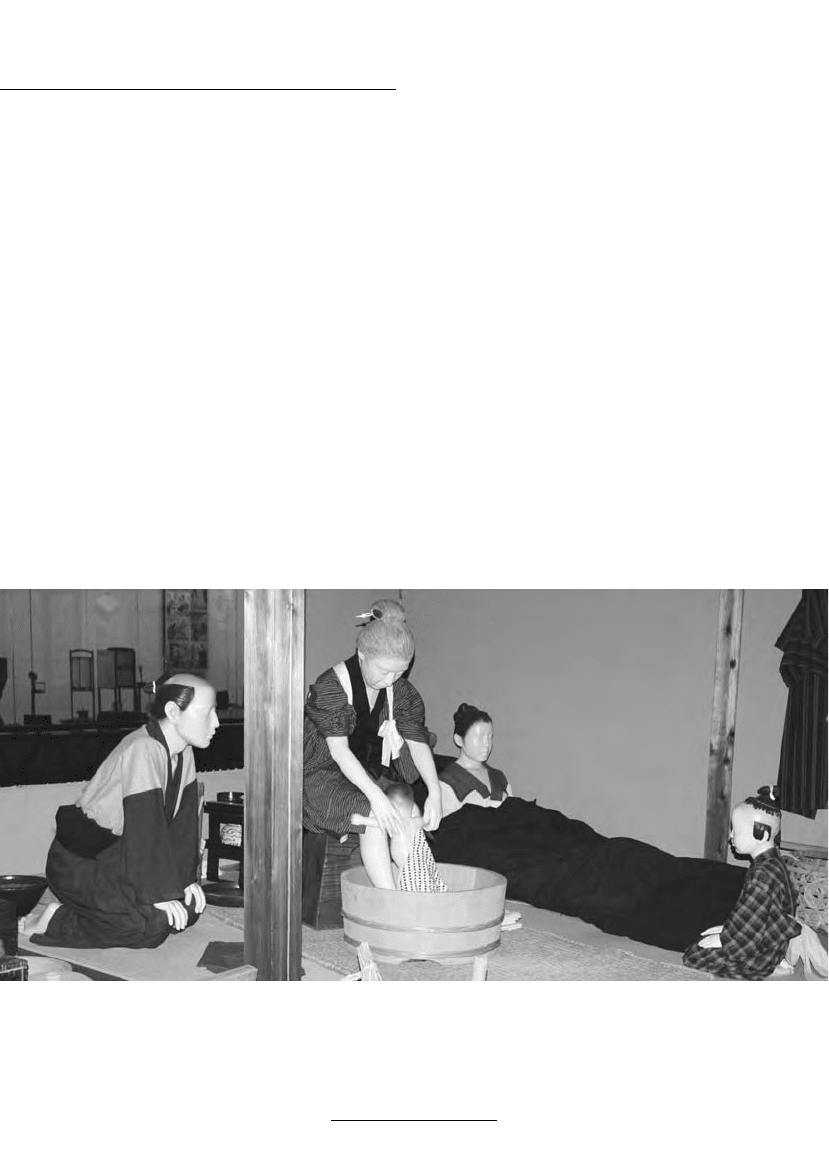
PREGNANCY AND
CHILDBIRTH
Pregnancy
In the early modern period, the first decision to be
made by a family once it was discovered that a
woman was pregnant was whether or not the fetus
should be carried to term. Many families, especially
those who were feeding and clothing a number of
children already, felt that they could not afford to
bring another child into the world. Abortion,
despite being illegal and also dangerous to the life of
the mother given the lack of understanding about
infection, was not uncommon in the cities. The
countryside witnessed a different method of birth
control, namely smothering the baby after birth,
perhaps due to the family’s desire to discover if they
had conceived a son or a daughter before making
such a decision.
If the decision was made to carry the pregnancy
to term, special rituals were performed that were
believed to protect the health of both the mother
and her unborn fetus. One such ritual, obi iwai,
called for a sash (obi) to be tied round the mother’s
waist at the fifth month of pregnancy to help guar-
antee a safe and painless delivery. Depending on the
local customs, this sash could be fashioned out of a
loincloth belonging to the husband, or sent to the
mother-to-be by her parents, or even borrowed
from a shrine whose deity specialized in matters of
childbirth. As the weeks passed, the family made
religious prayers and offerings, and the mother was
cautious to avoid certain foods deemed detrimental
to the natal process.
Childbirth
According to Shinto tradition, birth was defiling
because blood caused ritual impurity. In order to
minimize this impurity, a family with sufficient eco-
nomic resources typically erected a special building
E VERYDAY L IFE
347
12.4 Scene of Edo-period urban domestic life: giving birth (Edo-Tokyo Museum exhibit; Photo William E. Deal)

outside the home, inside which the labor and deliv-
ery, overseen by a midwife, took place. The mother
delivered the child either in a squatting position or
in a specially designed bed, and the umbilical cord
was cut with a bamboo or steel knife. Seven days
later, relatives and friends were invited to pay a visit
to the new family. It was on this day that the new-
born received his or her name. (See “Shichiya” in the
section on Festivals and Yearly Rituals below.)
The upper classes often availed themselves of
foster mothers or wet nurses, particularly if the
mother was too busy to nurse or had died in child-
birth. A typical lower-class woman, however, rarely
spent a minute of her time apart from her infant. A
baby spent most of its daytime hours strapped to
its mother’s back by a broad cloth wrapped across
its back and underneath its buttocks. It was in-
termittently taken out for feedings which, it should
be noted, were carried on for far longer than
Western standards of that time. Even when the
child grew old enough to spend the night in its
own bed, it continued to sleep in the company of its
parents.
FOOD AND DRINK
Japanese eating customs varied widely depending on
socioeconomic status. Typically, religious figures
and those in the upper classes ate about two meals
per day, one before noon and the other in the late
afternoon or early evening. Later, following the lead
of the warrior classes during the mid-Edo period,
nobles and monks developed the habit of eating
three meals per day, with the largest meal being con-
sumed in the evening. Meanwhile, the poor involved
in physical labor might consume up to four meals a
day.
Buddhist dietary guidelines banned the con-
sumption of meat because it was deemed impure and
spiritually defiling. Correspondingly, nobles typi-
cally did not eat meat products, although some of
the upper class did enjoy it in secret. In contrast, it
was fairly common for those of the warrior and
lower classes to consume meat on a regular basis.
Cooking
Japanese cooking was filled with the staples of
seafood, marine vegetation, and rice. Because of reli-
gious stipulations, animal products were not typi-
cally used in food preparation. Instead, common
ingredients included soybean products such as miso,
a nutritious grain and soybean paste made with rice
or barley, and mirin, a sweetened version of sake
used in combination with vinegar and soy sauce.
Common spices used included ginger, wasabi (Japan-
ese horseradish) and sansho (a dried green powder
made from grinding the seedpods of the prickly ash
tree). Usually, these products could be found at local
town markets, which often had a great supply of
fruits, vegetables, seafood, and other food products
for the general populace.
In the 13th century, a form of cooking known as
shojin ryori (“diligence cuisine”) was introduced to
Japan by Chinese Zen monks. This is a form of veg-
etarian cooking that utilizes fresh, seasonal vegeta-
bles, seaweed, tofu, and other fresh ingredients
prepared in a simple manner. This form of Buddhist
cooking reflects the Buddhist admonition against
killing any form of life. During the Edo period,
Japanese cuisine acquired an assortment of new
influences from China, Korea, and Western coun-
tries such as Portugal and Spain.
Sake
One of the most popular drinks within Japan was
sake, or rice wine. This alcoholic beverage began as a
drink commonly consumed within group or social
settings, such as celebrations, festivals, or parties.
During the Edo period, however, sake developed
into an everyday drink that could easily be purchased
at local markets and was consumed with regularity.
Dining Etiquette
The manner in which meals were consumed
depended on several factors, including a family’s
H ANDBOOK TO L IFE IN M EDIEVAL AND E ARLY M ODERN J APAN
348
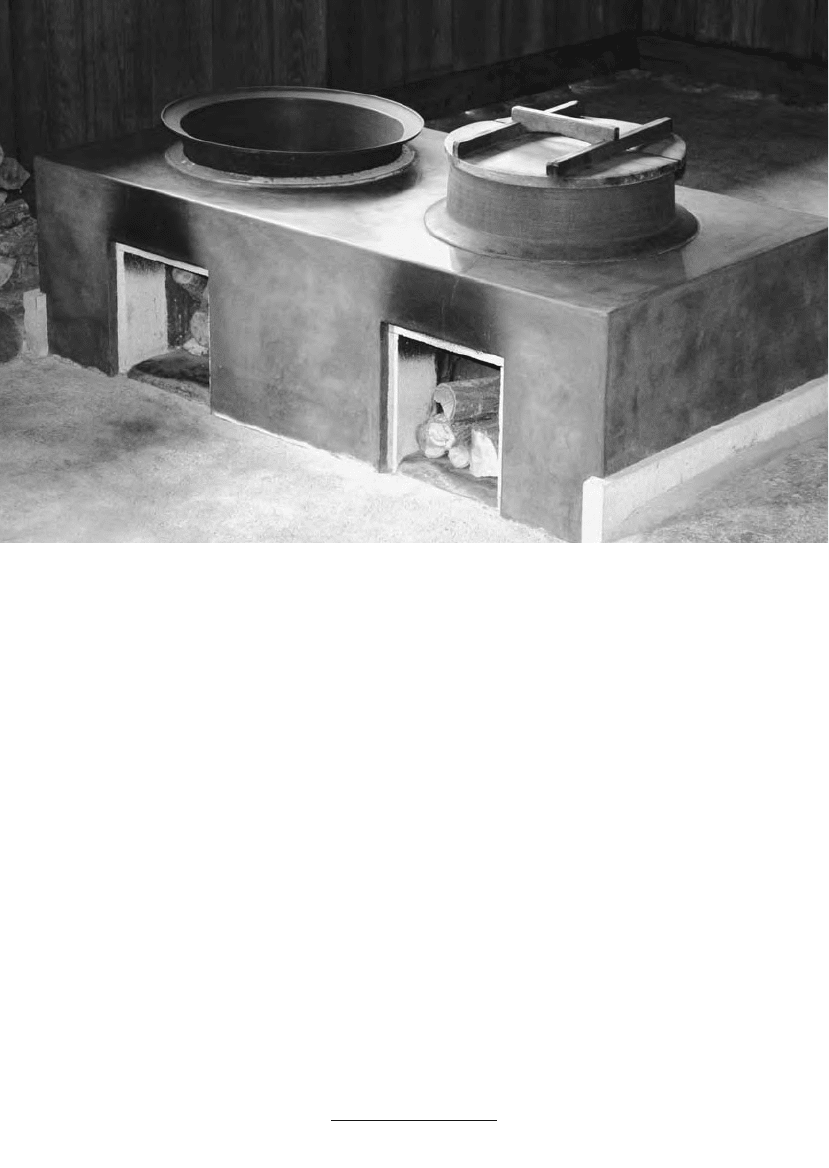
socioeconomic status and the rank of individual
members within a family, and could differ widely
from household to household. The male head of the
household, who typically dined with guests and, on
occasion, his eldest son, was served his meals by his
wife and/or daughter-in-law. The women dined sep-
arately from the men, catching quick bites of their
meal in the time between trips to serve the head of
household. The head’s wife was generally served by
her daughter-in-law and, in more affluent house-
holds, both of these women were assisted by maid-
servants.
The traditional style of serving meals was fairly
systematic. The person serving the meal would
place an individual lacquer tray, approximately
18 inches square and on legs roughly nine inches
high, in front of the diner. The entire meal, except
for the rice, was presented on this tray. The rice,
served next, constituted the bulk of the meal
and was therefore eaten in generous amounts.
Proper etiquette advised that one leave a few grains
of rice in the bowl when passing it back for more,
and it was not unusual for each person to consume
three full bowls of rice at a single meal. Either
disposable chopsticks (hashi) made of untreated
wood or reusable chopsticks made of lacquer, ivory,
or expensive metal were utilized during the meal.
The meal was officially concluded after green tea
made from the unfermented leaf (unlike the pow-
dered tea of the tea ceremony) had been served,
toothpicks had been utilized, and thanks had been
given.
The assortment of food items, like many other
things in life, was often an accurate indicator of a
family’s position in society. Those at the lower rungs
of Japanese society often ate markedly simple meals
consisting of a miso-based soup, vegetables, rice or a
mixture of rice and wheat, pickles, and tea.
E VERYDAY L IFE
349
12.5 Kitchen stove in a traditional country home (Photo William E. Deal)
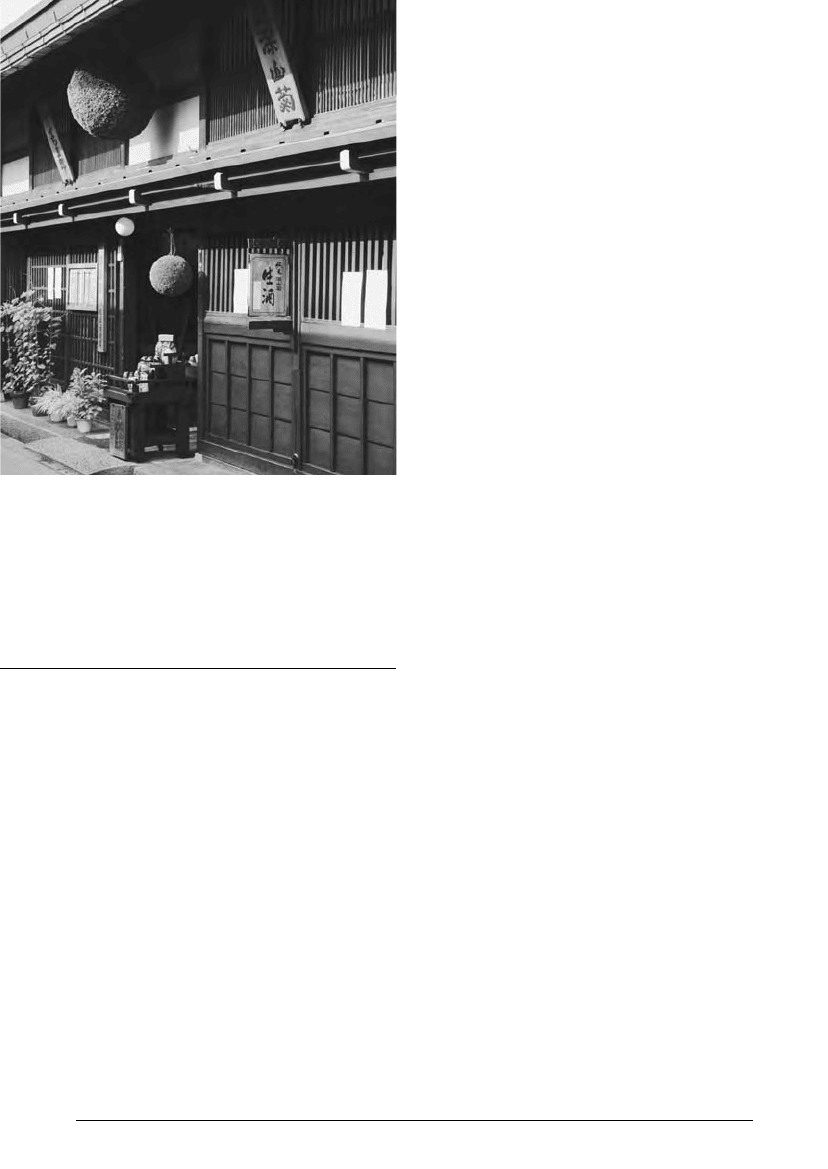
DRESS AND PERSONAL
APPEARANCE
Hair
Hair was a powerful symbol in Japan as it reflected
status, age, class, and sexuality. Samurai hairstyles
were pragmatic. Men wore their hair in a topknot,
and this style influenced commoner fashion in the
13th century. Women’s hair was usually long, worn
down, and kept straight. During the 16th century,
women began to put their hair up and utilize styles
that were more elaborate and decorative. Some-
times, women were punished by being forced to cut
their hair, a symbolic gesture representing humilia-
tion and debasement.
Most decorative hair ornaments were made of
bamboo, wood, tortoise shell, or ivory. One such
common item was the comb. Combs were crafted
out of gold and pearl in the medieval period. Elabo-
rate forms, styles, and designs developed during the
Edo period. Other decorative items found in the
early modern period included the stylized kanzashi
hair ornament and the kogai hairpin, used by both
men and women to manage their hair. Also develop-
ing in the Edo period were the kamiyui, hairstylists
who made house calls or opened up their own
salons, most notably within big cities.
Cosmetics and Accessories
Facial cosmetics were worn by both male and female
aristocrats on a regular basis during the medieval
and early modern periods. A pale complexion was
considered to be most desirable and was sought after
by many women. The traditional white face powder,
oshiroi, was often employed to achieve such an effect.
Other popular fashions for women included apply-
ing a red dot on their lower lip using a flower-based
paste, and the practice of okimayu, in which aristo-
cratic women shaved and re-drew their eyebrows
using a paint called mayuzumi. Okimayu was prac-
ticed starting in adolescence within the wealthy
classes and was practiced by everyday women during
special life events such as marriage and childbearing.
Beni was a rouge applied to the lips, and during the
18th century, sasabeni, a fashionable form of rouge
with a green hue, also became popular. Other skin
care items included nukabukuro, a face and body
wash made of rice bran, and various facial lotions
made from cucumber and gourd juice.
A common trend in dental fashion was ohaguro,
the practice of using an oxidized liquid to blacken
one’s teeth. This custom was thought to increase
attractiveness in addition to preserving the teeth.
While ohaguro was originally practiced only by
women, it became common among noblemen and
warriors during the 12th century before later revert-
ing to a practice only for women in the 18th century.
Tattoos as cosmetic items have a varied history in
medieval and early modern Japan. Until 1720, tat-
toos were used as punishments. Designs were placed
on the arm and face to mark offenses. In the Genroku
period (1688–1704), tattoos became fashionable
H ANDBOOK TO L IFE IN M EDIEVAL AND E ARLY M ODERN J APAN
350
12.6 Sake shop in Edo-period style (Photo William E.
Deal)
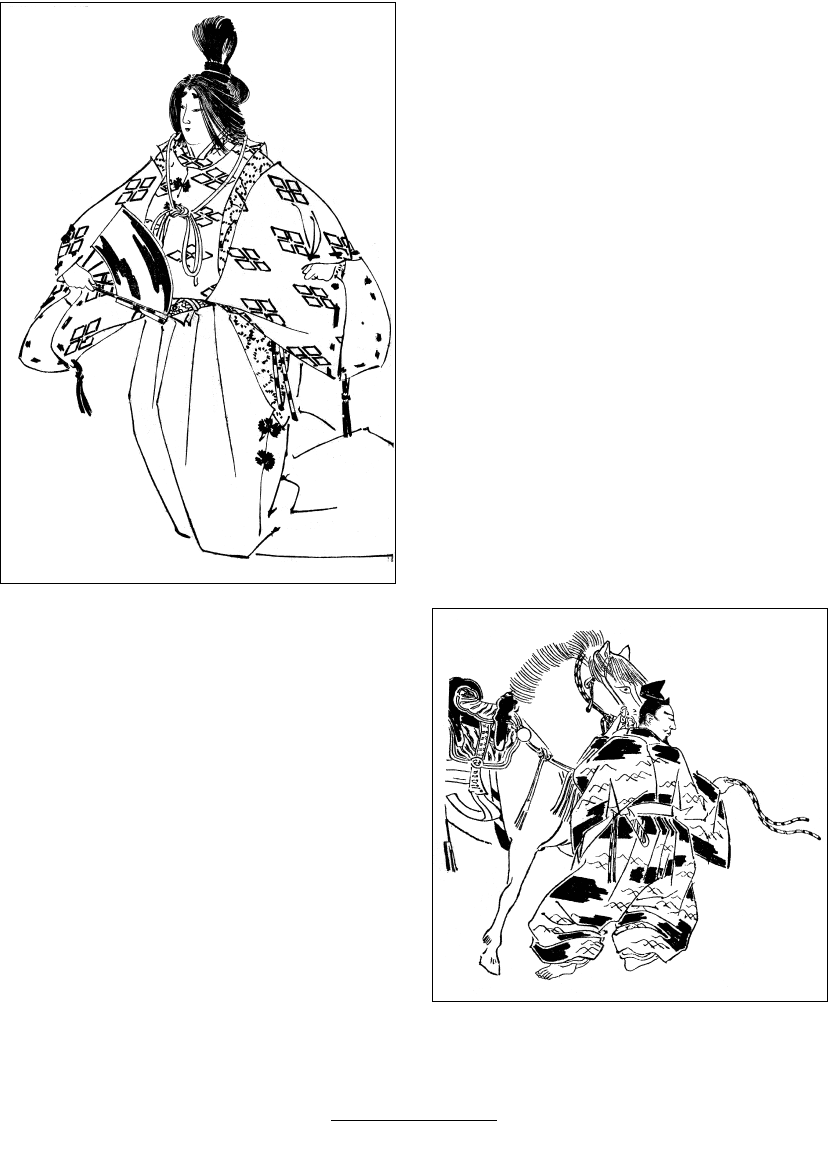
among prostitutes who often received kisho-bori tat-
toos or “pledge marks” to indicate their favorite
clients. However, tattoos reached their artistic and
popular peak during the mid-19th century. Especially
trendy among the townspeople, tattoos of the time
exhibited elaborate, colorful designs that often cov-
ered an extensive portion of the body. To make these
intricate, designs, great skill was needed, creating a
market for specialized tattoo artists called horishi.
A final type of fashion accessory was the fan or
uchiwa, used in a wide range of contexts, including
within battle, during ceremonies, and as personal
accessories. Folding fans, or ogi, were status symbols
that were also used in a variety of settings, including
dance performances, theatrical productions, and tea
ceremonies.
Clothing
During the Kamakura period, the typical warrior
uniform consisted of a hunting jacket, kariginu, and
a cloak (suikan). Women’s formal attire included the
uchiki robe and hakama skirt-trousers with the
kosode, a silk garment with short sleeves added to the
ensemble at a later time. The uchikake or kaidori, a
long jacket, developed in the Muromachi period,
while the kamishimo, a matching sleeveless top and
bottom ensemble worn by the samurai, arose during
the Azuchi-Momoyama period, an era in which
Japanese fashion began to show Chinese and Por-
tuguese influence. During the late 14th and early
15th centuries, the use of cotton became widespread
for people of all socioeconomic classes. Individuals
enjoyed the texture and washability of the fabric,
especially commoners, whose attire was often
uncomfortable. Led by the Kabuki theater fashions,
Edo-period clothing saw the expansion of elaborate,
lavish fashion designs, decorated with newly devel-
oped dyes. Toward the end of the period, the gov-
ernment placed restrictions on such overly flashy
attire, causing citizens to modify their standards of
E VERYDAY L IFE
351
12.7 Kamakura-period aristocratic woman (Illustration
Kikuchi Yosai from Zenken kojitsu, mid-19th century)
12.8 Everyday medieval warrior attire (Illustration
Kikuchi Yosai from Zenken kojitsu, mid-19th century)
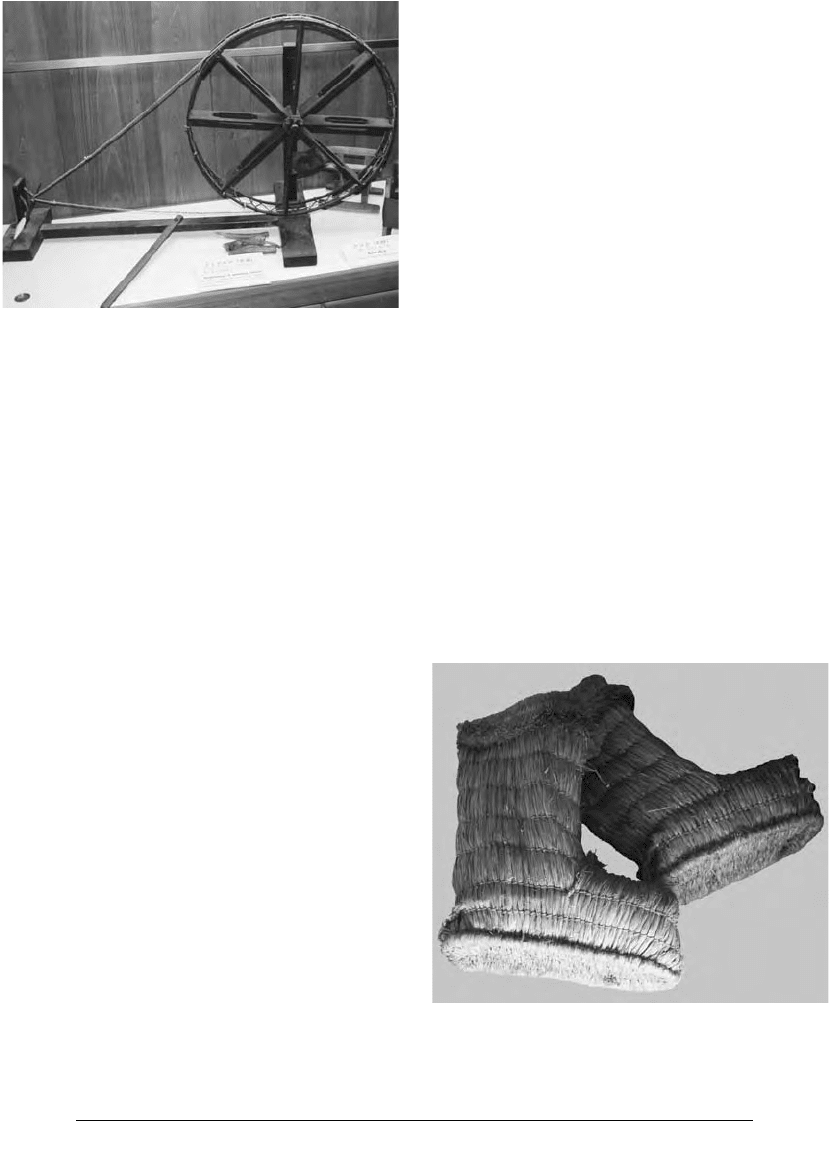
fashion and beauty. Typical apparel of this time
included the kosode, a sash, and the haori, a short
jacket. Military uniforms also incorporated the
kosode, hakama, and haori.
Commoners often wore simple outfits consisting
of a smock, trousers, and an overcoat. Women tradi-
tionally wore kimonos with girdles called yumaki,
often layered if the weather demanded. Sometimes
commoners went barefoot or wore straw sandals
called ashinaka. Due to especially hot summers,
nudity was acceptable and not subject to embarrass-
ment or scorn within the working classes. Thus, it
was not uncommon or inappropriate for men to
wear only a loincloth or for women to work the
fields topless.
While the shogunate stipulated that courtesans
should wear only simple clothing, it was clear that
they did not always follow such guidelines. Courte-
sans were, however, not permitted to wear any socks,
leaving them barefoot even during the winter.
Going barefoot became a valued symbol of disci-
pline for these women. Furthermore, naked feet
were considered sexually alluring, especially since
the courtesans often used nail polish.
Japanese clothing varied greatly among social
classes. Both the style and color of attire were mark-
ers of socioeconomic status and gender distinctions.
Despite this diversity, however, one article of cloth-
ing that was commonly used by people of all classes
was the kosode, or kimono, as it came to be known
during its widespread use in the 18th century. The
kimono was an efficient form of clothing—it was
easy to create, wasted no fabric in the manufacturing
process, and was readily adaptable to fit different
individuals and body types. Two special types of
kimono were the yukata, commonly worn in the
summer and made of white cotton occasionally with
blue dye, and the furisode, worn by young women of
nobility in the Edo period and marked by longer,
extended sleeves.
Traditional Japanese headgear included the kasa,
a hat made of straw, sedge, and other materials, and
often formed into different shapes symbolic of an
individual’s class status. Headcoverings included the
cotton cloth tenugui and zukin, and headbands called
hachimaki. Hachimaki were typically worn by indi-
viduals under great duress, such as warriors in battle,
women giving birth, and men involved in strenuous
physical labor.
Sandals were the most common form of foot-
wear, as they were cheap, convenient, and easy to
make. The most notable forms of such footwear
were the straw waraji used for long trips by foot,
geta, which were wooden clogs often worn by urban
dwellers, and zori, a sandal commonly worn with
kimono. Typical raingear included the kasa hat, the
Portuguese-influenced rain cape known as a kappa,
and a type of geta used as rain footwear, the ashida.
H ANDBOOK TO L IFE IN M EDIEVAL AND E ARLY M ODERN J APAN
352
12.9 Edo-period spinning wheel (itoguruma) used for
making cloth
(Photo William E. Deal)
12.10 Straw boots (zunbe) worn in the countryside
during winter
(Photo William E. Deal)

Everyday Etiquette
Guidelines for personal decorum differed depending
on such factors as an individual’s social class, gender,
and rank within his or her family. For example, a
wife was expected to walk a pace behind her husband
when they appeared together in a public setting, a
relatively infrequent occurrence. In the household,
individuals were expected to situate themselves in a
very particular sitting position that had been taught
to them since childhood. Sitting back on the heels,
with the ankles nearly sideways on the floor, allowed
the feet to form a cup which comfortably accommo-
dated the buttocks. When a woman was receiving
guests, bidding farewell, or taking orders, she placed
her hands on the floor and bowed quite low to the
ground, lowering her forehead between her hands.
Men bowed in a similar fashion, but not quite so
low, and were permitted to sit in a cross-legged posi-
tion in less formal situations. Outside of the home,
people simply bowed to each other from the waist,
only demonstrating respect by bowing to the ground
when a personage of high authority, such as a
daimyo, passed by.
When greeting others, it was expected that
people would remove items worn for work, such
as protective clothing or spectacles. Since it
was considered rather rude to breathe on other
people, the custom was to position the hand in
front of the mouth while speaking to superiors.
For the same reason, when handling sacred or oth-
erwise important objects, a piece of paper was
placed in the mouth to protect the items from des-
ecration.
SPORTS AND
DIVERSIONS
Sports and Games
In addition to the martial arts outlined in chapter 5:
Warriors and Warfare, Japan also enjoyed a hand-
ful of other sporting activities. One of the most re-
nowned and distinctive of these sports was the form
of wrestling called sumo. In sumo two wrestlers,
wearing only a special loincloth belt called a ma-
washi, compete in a dohyo—a central clay ring
surrounded by bags of straw—where they must
force their opponent to step out of the circle or
touch the ground with any part of their body
except the feet. The match lasts for only a brief
amount of time and is arbitrated by the gyoji (ref-
eree). Sumo dates back to before the medieval
period, but it first became a professional sport dur-
ing the Edo period. Other sports included cock-
fighting, fishing, and falconry.
Outside of the traditional sports of the day, the
athletic kickball game kemari was popular among the
nobility during the Kamakura period. Kemari con-
sisted of people trying to kick a ball around a circle
while not letting it touch the ground. This game,
along with the associated handball temari, eventually
was picked up and enjoyed by the lower classes as
well. Hanetsuki—a badminton-like game played by
girls with wooden paddles and a shuttlecock—and
the otedama beanbag game were two other athletic
diversions found in early modern Japan.
Two of the most prominent board games played
in Japan were go and shogi. Go is a classic game of
strategy played by two individuals moving black and
white stones across a wooden board. During the
17th century, annual go matches were held for the
shogun at Edo castle. Go competition was excep-
tionally competitive and specialized schools were
established to train individuals in the art of playing
this game. Shogi was a related game that resembles
the Western game of chess. An official governmen-
tal agency to oversee go and shogi was established by
the Tokugawa shogunate in 1607. Finally, a board
game played with dice called sugoroku, comparable
to backgammon, became especially popular from
the 17th century. The goal of the game was to move
all of one’s pieces into the opponent’s territory. One
version of sugoroku was played on a board inscribed
with scenes of both the Buddhist Pure Land and
the Buddhist hells. The goal of Pure Land sugoroku,
as it was called, was to attain entry into the Pure
Land associated with Amida Buddha. (see chapter 6:
Religion, for details on the Pure Land school of
Buddhism.)
E VERYDAY L IFE
353
